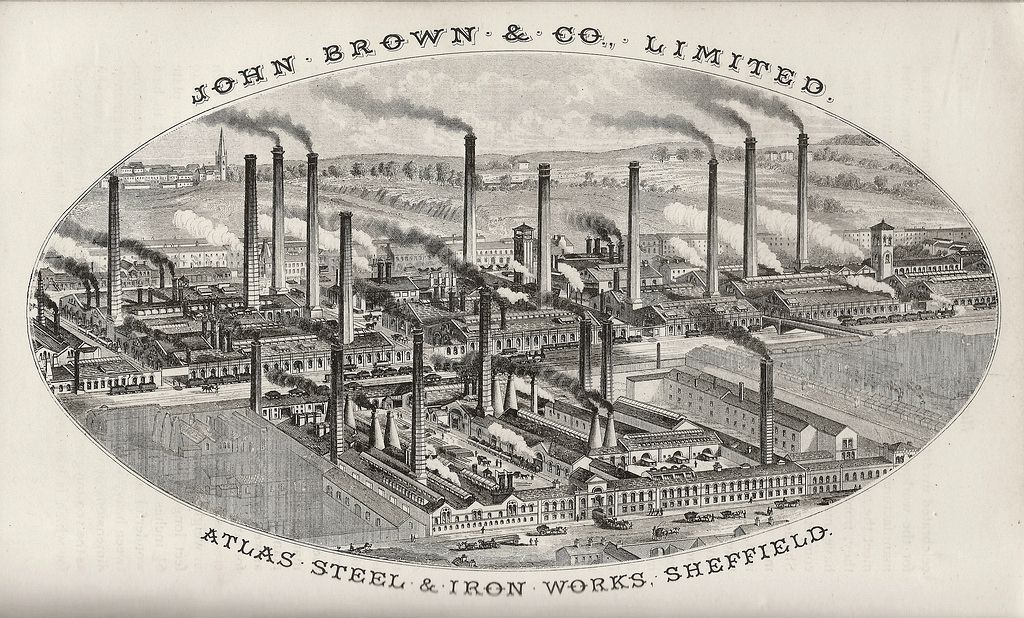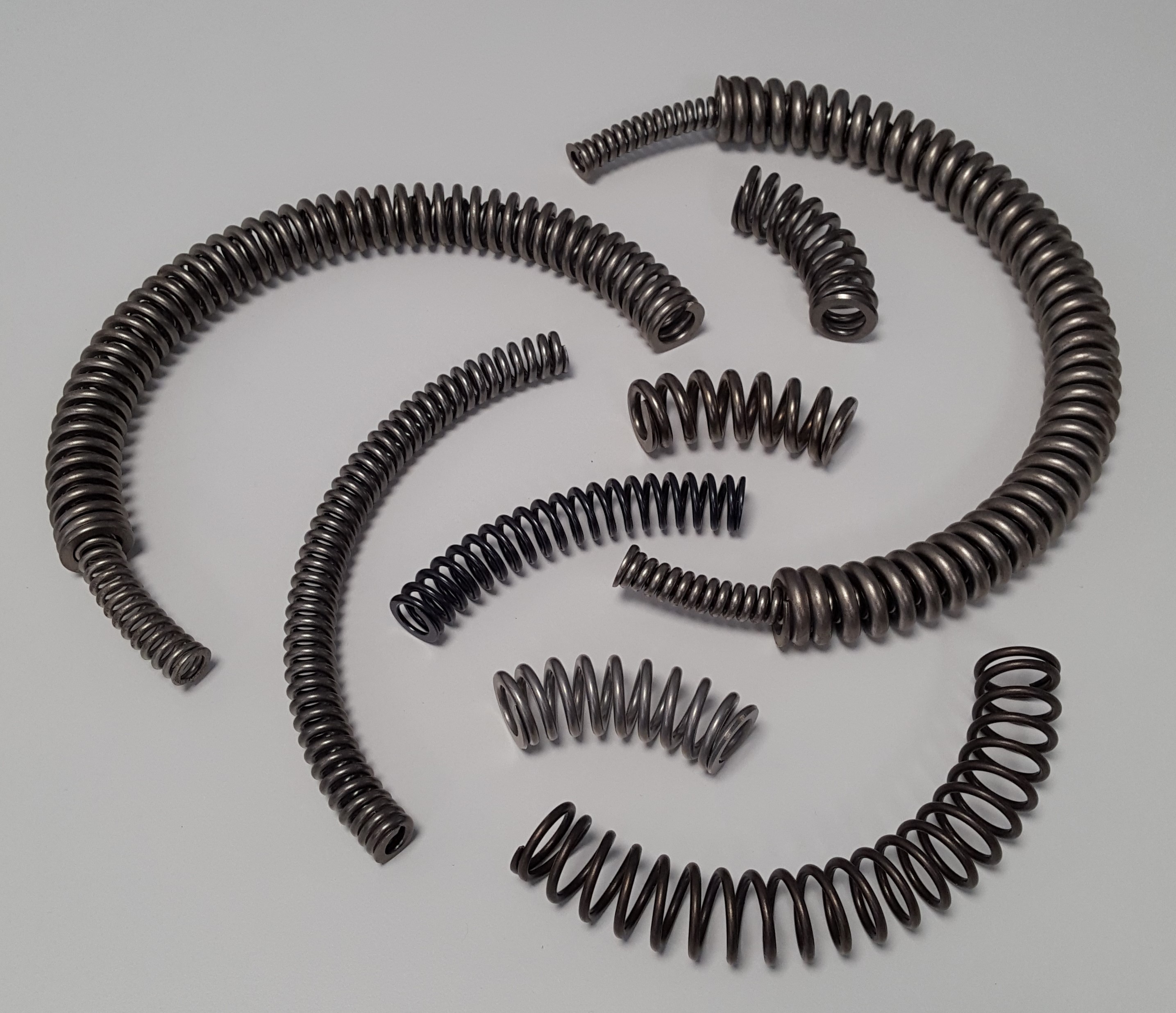|
Volute Spring
A volute spring, also known as a conical spring, is a compression spring in the form of a cone (somewhat like the classical volute decorative architectural ornament). Under compression, the coils slide past each other, thus enabling the spring to be compressed to a very short length in comparison with what would be possible with a more conventional helical spring. There are two typical types of volute spring: *The first has a shape for the initial spring steel (or other material for the wound spring) as a "V", with one end wider than the other *The second is the double volute, having two "V" shapes facing away from each other, which forms a distorted cylinder having a wider diameter at the centre than at the ends, forming symmetric attachment points Double volute springs can frequently be found as a component of garden pruning shears. Short posts anchored in each side of the handles, and inserted into each narrow end of the spring, keep the spring in position. However, the applic ... [...More Info...] [...Related Items...] OR: [Wikipedia] [Google] [Baidu] |
Spring (device)
A spring is an elastic object that stores mechanical energy. In everyday use the term often refers to coil springs, but there are many different spring designs. Modern springs are typically manufactured from spring steel, although some non-metallic objects like the bow are also springs. When a conventional spring, without stiffness variability features, is compressed or stretched from its resting position, it exerts an opposing force approximately proportional to its change in length (this approximation breaks down for larger deflections). The ''rate'' or ''spring constant'' of a spring is the change in the force it exerts, divided by the change in deflection of the spring. That is, it is the gradient of the force versus deflection curve. An extension or compression spring's rate is expressed in units of force divided by distance, for example or N/m or lbf/in. A torsion spring is a spring that works by twisting; when it is twisted about its axis by an angle, it produc ... [...More Info...] [...Related Items...] OR: [Wikipedia] [Google] [Baidu] |
Volute
A volute is a spiral, scroll-like ornament that forms the basis of the Ionic order, found in the capital of the Ionic column. It was later incorporated into Corinthian order and Composite column capitals. Four are normally to be found on an Ionic capital, eight on Composite capitals and smaller versions (sometimes called ''helix'') on the Corinthian capital. The word derives from the Latin ''voluta'' ("scroll"). It has been suggested that the ornament was inspired by the curve of a ram's horns, or perhaps was derived from the natural spiral found in the ovule of a common species of clover native to Greece. Alternatively, it may simply be of geometrical origin."Volute". ''The Concise Oxford Dictionary of Archaeology''. Timothy Darvill. Oxford University Press, 2002 The ornament can be seen in Renaissance and Baroque architecture and is a common decoration in furniture design, silverware and ceramics. A method of drawing the complex geometry was devised by the ancient Roman arc ... [...More Info...] [...Related Items...] OR: [Wikipedia] [Google] [Baidu] |
Helical Spring
A selection of conical coil springs The most common type of spring is the coil spring, which is made out of a long piece of metal that is wound around itself. Coil springs were in use in Roman times, evidence of this can be found in bronze Fibulae - the clasps worn by Roman soldiers among others. These are quite commonly found in Roman archeological digs. Coil springs can be either compression springs, tension springs or torsion springs, depending on how they are wound. A coil spring is a mechanical device which is typically used to store energy and subsequently release it, to absorb shock, or to maintain a force between contacting surfaces. They are made of an elastic material formed into the shape of a helix which returns to its natural length when unloaded. They are commonly used in mattresses, automotive suspensions, and residential plumbing. Coil springs come in a variety of sizes and shapes and can be used for a variety of applications. Small coil springs are often us ... [...More Info...] [...Related Items...] OR: [Wikipedia] [Google] [Baidu] |
Pruning Shears
Pruning shears, also called hand pruners (in American English), or secateurs (in British English), are a type of scissors for use on plants. They are strong enough to prune hard branches of trees and shrubs, sometimes up to two centimetres thick. They are used in gardening, arboriculture, plant nursery works, farming, flower arranging, and nature conservation, where fine-scale habitat management is required. Loppers are a larger, two-handed, long-handled version for branches thicker than pruning shears can cut. History Cutting plants as part of gardening dates to antiquity in both European and East Asian topiary, with specialized scissors used for Chinese penjing and its offshoots – Japanese bonsai and Vietnamese Hòn Non-Bộ – for over a thousand years. In modern Europe, scissors only used for gardening work have existed since 1819, when the French aristocrat Antoine-François Bertrand de Molleville was listed in "Bon Jardinier", as the inventor of secateurs. During th ... [...More Info...] [...Related Items...] OR: [Wikipedia] [Google] [Baidu] |
Railway Car
A railroad car, railcar ( American and Canadian English), railway wagon, railway carriage, railway truck, railwagon, railcarriage or railtruck (British English and UIC), also called a train car, train wagon, train carriage or train truck, is a vehicle used for the carrying of cargo or passengers on a rail transport system (a railroad/railway). Such cars, when coupled together and hauled by one or more locomotives, form a train. Alternatively, some passenger cars are self-propelled in which case they may be either single railcars or make up multiple units. The term "car" is commonly used by itself in American English when a rail context is implicit. Indian English sometimes uses "bogie" in the same manner, though the term has other meanings in other variants of English. In American English, "railcar" is a generic term for a railway vehicle; in other countries " railcar" refers specifically to a self-propelled, powered, railway vehicle. Although some cars exist for t ... [...More Info...] [...Related Items...] OR: [Wikipedia] [Google] [Baidu] |
M4 Sherman
} The M4 Sherman, officially Medium Tank, M4, was the most widely used medium tank by the United States and Western Allies in World War II. The M4 Sherman proved to be reliable, relatively cheap to produce, and available in great numbers. It was also the basis of several other armored fighting vehicles including self-propelled artillery, tank destroyers, and armored recovery vehicles. Tens of thousands were distributed through the Lend-Lease program to the British Commonwealth and Soviet Union. The tank was named by the British after the American Civil War General William Tecumseh Sherman. The M4 Sherman evolved from the M3 Medium Tank, which for speed of development had its main armament in a side sponson mount. The M4 retained much of the previous mechanical design, but moved the main 75 mm gun into a fully traversing central turret. One feature, a one-axis gyrostabilizer, was not precise enough to allow firing when moving but did help keep the gun aimed in rou ... [...More Info...] [...Related Items...] OR: [Wikipedia] [Google] [Baidu] |
John Brown (industrialist)
Sir John Brown (6 December 1816 – 27 December 1896), British industrialist, was born in Sheffield. He was known as the Father of the South Yorkshire Iron Trade. Background He was born at Sheffield in Flavell's Yard, Fargate, on 6 December 1816. He was the second son of Samuel Brown, a slater of that town. He was educated at a local school held in a garret, and was apprenticed at the age of fourteen to Earl, Horton, & Co., factors, of Orchard Place, In 1831, his employers engaged in the manufacture of files and table cutlery, taking an establishment in Rockingham Street, which they styled the Hallamshire Works. Nonetheless he did take over the company's factoring business with the help of a loan for £500 thanks to the backing of his father and uncle and for several years travelled the country selling goods.''"Aspects of Sheffield 1"'', Melvyn Jones (Editor), , Chapter "Endcliffe Hall: A Gentleman Industrialist Residence” by Julie Goddard Gives biography of Brown. In ... [...More Info...] [...Related Items...] OR: [Wikipedia] [Google] [Baidu] |
Buffer (rail Transport)
A buffer is a part of the buffers-and-chain coupling system used on the railway systems of many countries, among them most of those in Europe, for attaching railway vehicles to one another. Description Fitted at the ends of the vehicle frames on the buffer beam, one at each corner, the buffers are projecting, shock-absorbing pads which, when vehicles are coupled, are brought into contact with those on the next vehicle. The buffer itself comprises the buffer plates which take the impact. The draw chain used between each pair of vehicles includes a screw which is tightened after coupling to shorten the chain and keep the buffers pressed together. Such is known as a 'screw coupling'. Historically, coupling chains were no more than that, a short length of heavy chain (typically three links long) with no adjustment. These would result in a 'loose-coupled train' in which the buffers of adjacent vehicles would only touch when the coupling chain was fully slack, such as when being p ... [...More Info...] [...Related Items...] OR: [Wikipedia] [Google] [Baidu] |
Coil Spring
A selection of conical coil springs The most common type of spring is the coil spring, which is made out of a long piece of metal that is wound around itself. Coil springs were in use in Roman times, evidence of this can be found in bronze Fibulae - the clasps worn by Roman soldiers among others. These are quite commonly found in Roman archeological digs. Coil springs can be either compression springs, tension springs or torsion springs, depending on how they are wound. A coil spring is a mechanical device which is typically used to store energy and subsequently release it, to absorb shock, or to maintain a force between contacting surfaces. They are made of an elastic material formed into the shape of a helix which returns to its natural length when unloaded. They are commonly used in mattresses, automotive suspensions, and residential plumbing. Coil springs come in a variety of sizes and shapes and can be used for a variety of applications. Small coil springs are often us ... [...More Info...] [...Related Items...] OR: [Wikipedia] [Google] [Baidu] |
Springs (mechanical)
Spring(s) may refer to: Common uses * Spring (season), a season of the year * Spring (device), a mechanical device that stores energy * Spring (hydrology), a natural source of water * Spring (mathematics), a geometric surface in the shape of a helically coiled tube * Spring (political terminology), often used to name periods of political liberalization * Springs (tide), in oceanography, the maximum tide, occurs twice a month during the full and new moon Places * Spring (Milz), a river in Thuringia, Germany * Spring, Alabel, a barangay unit in Alabel, Sarangani Province, Philippines * Șpring, a commune in Alba County, Romania * Șpring (river), a river in Alba County, Romania * Springs, Gauteng, South Africa * Springs, the location of Dubai British School, Dubai United States * Springs, New York, a part of East Hampton, New York * Springs, Pennsylvania, an unincorporated community * Spring, Texas, a census-designated place * Spring District, neighborhood in Bellevue, Washin ... [...More Info...] [...Related Items...] OR: [Wikipedia] [Google] [Baidu] |

.jpg)





